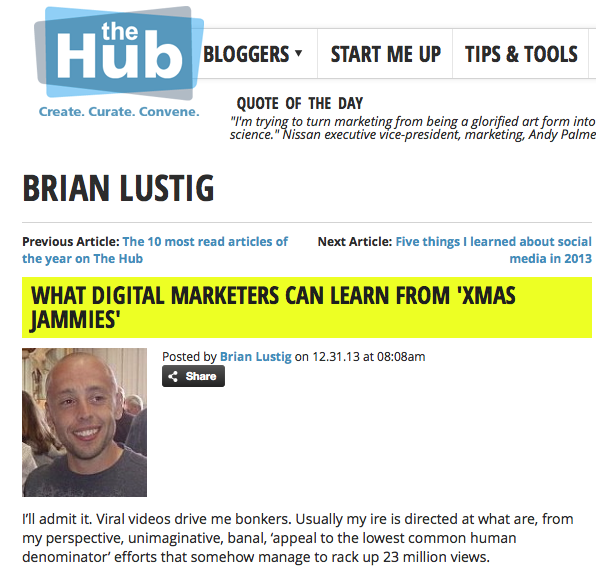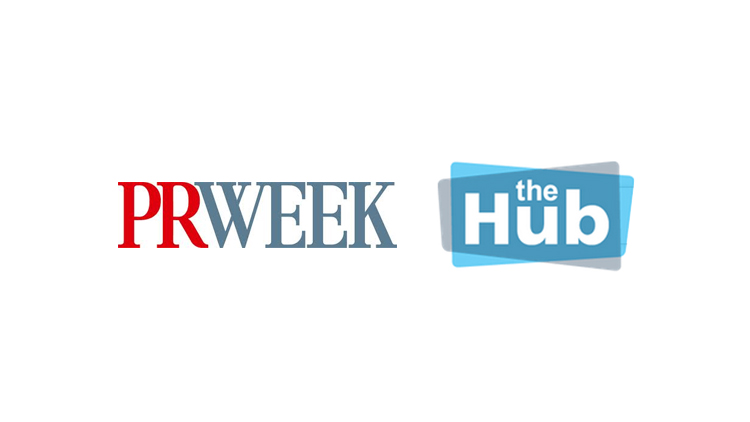By now, you may be one of the more than 13 million YouTube visitors who have viewed the clever, genuine yet very purposeful Xmas Jammies video, or saw it on any number of major broadcast outlets that picked it up. For marketing, creative, and PR professionals, viral videos can be maddeningly elusive. There are some characteristics universal to viral videos, but just as many that fall In the excerpt above, he discusses the technical problems with the federal health anthem insurance marketplace website and what his administration is doing to help consumers get enrolled in an anthem insurance plan. outside the blueprint as well.
In my latest article for PR Week “The Hub,” I take a look at some reasons why Xmas Jammies took off, and what digital marketers can learn from its success.


A pair of startups – Coin and Tile – are garnering significant attention for their recent product launches. In his most recent guest article for PR Week ‘the Hub,’ Bluetext Partner Brian Lustig discusses what technology companies and startups can take away from the success Coin and Tile are experiencing when it comes to how they have developed and executed their product launches.
Noise. This is a word that in some ways lies at the very core of what PR professionals must deal with every day. Often, our time is spent trying to create noise for a product, service or company; yet as much energy is spent trying to help clients rise above noise created in the market that threatens to drown out whatever message we are trying to deliver.
Noise is relevant in other areas of communications, and in my opinion can play a hand in common yet easy to fix mistakes that PR professionals often make. Here are five ways noise is negatively impacting the effectiveness of PR efforts, and why they are easy to fix.
Eliminate Noise Pitching HARO
Help A Reporter Out (HARO) needs little explanation at this point. It can be a tool for PR professionals to find out about media opportunities they might now have otherwise uncovered. But my guess is that 95 percent of PR folks follow the exact same template: 1) spot a query that looks relevant to a client, then submit a pitch along with the hundreds of others doing the same thing. That’s fine; there is little choice in this case to pitch into the noise, understanding that most of the time you will be drowned out.
But instead of only reaching out to reporters when a query is posted, how many of you take note of the types of stories a reporter is posting on, and then use that data at a later point to pitch a related angle at a time when the reporter won’t be slammed with pitches? If a reporter HARO query is about, for example, predicative analytics and your client is more focused on data visualization, investigate to see how wide the reporter’s coverage extends, and if relevant, pitch an article related to your client during a time when the entire HARO world isn’t also clamoring for the reporter’s attention. Even if you aren’t 100% sure the reporter will find your pitch on target, by referencing the initial HARO query you can at least provide credible context that you pay attention to what the reporter writes on.
Eliminate Noise With Speaker Submissions
We’d like to believe that each speaker submission is given equal attention – no matter if the submission is received the day after the call for speakers is posted or on the final submission day. But of course that is often not the case; submission reviewers aren’t just going to twiddle their thumbs during the speaker entry period and then wait until after the submission close date to plow through everything. They will no doubt feel less pressured and have more time to evaluate submissions on the front end of the submission period when the volume is lighter. It would not be outrageous to speculate that 60 percent or more of submissions come in during the final few days or week of the submission process, which means that judges and organizers have less time to devote to latter entries.
Eliminate Noise At Press-Attended Events
How many times have you showed up for an event where perhaps media are sitting on a panel, leading a topic discussion, or just attending to cover the event content? And how many times do you end up in a single file line behind other PR professionals who are forced to cram several minutes of conversation topic into 30 seconds of introductory chitchat? If you have a previous relationship with the reporter great, but if not, these events are terrible places to try and make an introduction. The environment is literally noisy, there is competition for the reporter’s attention, and there is pressure to try and have a meaningful conversation while several other people are impatiently waiting for their turn.
I’m going to add a caveat to this one, because I get the appeal of showing up at events where desired press is attending. Even if you can just spend a couple minutes dropping your name so that the next time you send an email or call there will at least be some recognition, there is potential value there. As opposed to trying to establish a first connection via emails and voice mails (which the reporter can easily ignore), an in-person exchange ensures you can at least get on his/her radar. But I’ll stick to the belief that beyond a name drop, these events are not well suited to have deeper conversations about your clients or pitches.
Eliminate Noise Around Social Media Efforts
We all have at least one person or organization we follow on Twitter that basically social media vomits all over our Twitter feed. It’s absurd, and highly ineffective. Too often, PR professionals and clients equate volume to engagement. In other words, the belief that the more an organization tweets and posts, the more engaged consumers and customers will interpret it to be. Social media noise exists when the organization uses popular channels to spew out content devoid of strategy, or content that does little to spark conversation or engagement. Yes, it is important to prevent social media profiles from going stale with outdated content, but the flipside is that too much content – particularly content that is of little value to the online community – is equally damaging.
Discussions around the current state of public relations – relative to where the industry was five years ago – inevitably boil down to the slow but steady demise of print newspapers and magazines, or that an organization absolutely must use social media, infographics, Slideshare, and so on.
I think that all kind of misses the point. Sure, maybe there aren’t as many CMOs busting into the Executive Suite brandishing a copy of The New York Times with a feature on their company with the assumption it will vault sales, or the brand, into the stratosphere.
It’s more about, ok, so I have a piece of content here that could be valuable for my company – in this case it’s a news article but it just as well could be a case study, or research paper, product launch announcement or marketing campaign – and now I have to figure out how to fully leverage it. Could the content be multi-purposed into a lead gen white paper campaign or speaker series? Can I use the content to capture new leads through a dedicated e-mail or search marketing campaign? And if I do these things, is my website optimized in a way to fully capture these leads? Finally, do I have a way to get these leads to my sales team to translate the content into new business?
Moving beyond the content, there is also a breakdown of what had been considered traditional channels to distribute content and communicate with consumers, partners, and customers. The channel is really anywhere that these target audiences reside. It might be the website for an industry publication, a webinar audience or physical Conference, but it could just as easily be Kickstarter, YouTube or Pinterest.
That, to me, is a big part of where public relations currently resides. The need for an integrated perspective that governs individual initiatives for PR, branding, digital, creative, social, advertising is key to ensuring that public relations efforts do not simply wander from one announcement to the next. This isn’t to say that today’s PR firm has to offer every single service, or that there isn’t a critical role for PR specialists to play. But it does mean that these moving parts must communicate and align with one another, and my opinion is that PR firms moving the needle today are the ones who understand how to make the pieces work together for the benefit of the client.